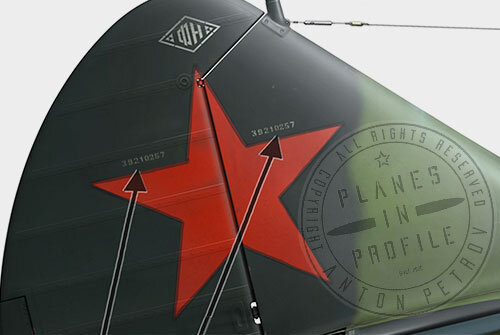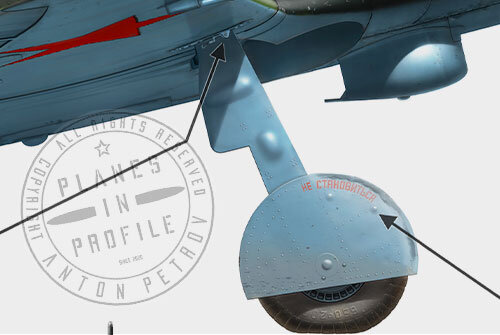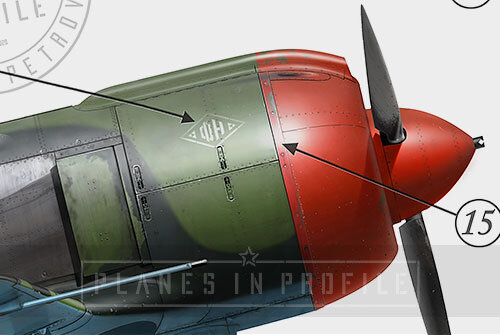White-57
Lavochkin, La-5FN (Early)
(Presumably) 32nd GIAP, 3-rd GIAD, 1-st GIAK, 15-th Air Army. Bryansk front, circa summer1943.
Flown by an unknown pilot.
What makes White-57 special is that this airplane is presumed to be one of the first La-5FNs to be flown in battle. These first La-5FNs were tested in battle by the 32-nd GIAP at the Bryansk Front in July-August of 1943 [1], at the time of the Kursk battles. Even though Kursk is famous for being the largest tank battle in history, it’s worth noting that the battle above ground was just as epic. Luftwaffe allocated 2,500 aircraft to take Kursk, the Soviets amassed 2600 aircraft to defend it. [2] (a similar number of aircraft as in the Battle of Britain on the German side and even more aircraft than in the Battle of Britain on the Allied side). Like the Battle of Britain, the clash at the Battle of Kursk would help to decide the outcome of WW2.
For this battle the Germans brought out some of their latest airplanes including the latest modification of the Focke-Wulf 190 where it would go head to head against the latest fighter plane on the Soviet side, the La-5FN, which White-57 was one of.
A passage from vvsairwar.com said it well :
‘While the Luftwaffe maintained air superiority during the first part of the battle, the Soviet pilots in La-5FNs were eventually able to show German airmen that the new plane not only had significant firepower, it had the speed and maneuverability to match the Messerschmitts and Focke-Wulfs. Indeed, the La-5FN’s climb rate and turning radius were superior to those of the Fw 190A-8A, and its roll rate was slightly better than the Bf-109. The new Lavochkin in the hands of a skilled Soviet pilot was as deadly as anything on the battlefield’. [3]
The training of many Soviet pilots improved in general by the summer of 1943, and many of the pilots of 32GIAP were already experienced fighter pilots by the time of the Kursk Battle. Behind the controls of a La-5FN the pilots of 32 GIAP were a serious force to be reckoned with, even for Luftwaffe’s aces.
‘In the course of one month, 14 Soviet fighter pilots of the 32-nd GIAP engaged in 25 air battles and have shot down 21 FW-190, three Me-109G-2, three He-111, five Ju-88 and one Ju-87. 33 planes in total. The losses on the part of 32-nd GIAP consisted of four airplanes’. [1]
For exemplary execution of battle missions in the fight against German invaders and display of valor and courage while doing so, by the decree of the head of Armed Forces of USSR on September 2-nd, 1943 the 32-nd regiment was awarded the ‘Order of Lenin’. [4].
Unfortunately I was unable to find the name of the pilot who flew the White-57. If any of you reading this have any information about it then please leave a comment below.
Noteworthy Visual Characteristics
1. Red “nose” was an identification marking of the 32-nd GIAK.
2. Note the arrangement of the locks. This arrangement can only be seen on some of the very early La-5FNs. The two front locks are as per the positioning of the locks on the La-5F models and the positioning of the two back locks is unique to the very early La-5FNs.
3. The sliding part of the canopy was removed on White-57.
Unfortunately I was unable to get permission to use the photo of White-57 which shows this part. That photo shows White-57 from the left side, mostly silhouetted against the sun, but one can still make out the number 57 and see that the antenna mast and the sliding part of the canopy on this aircraft are missing.
4. The vents in the heat protection panels are located at the back of the panel, which is consistent with the standard La-5FN arrangement . Keeping this piece of evidence in mind we can move on to point number 5.
5. We don’t know what the side panel on this plane looked like because it is covered by the wing in the photo reference. Using the fact that the heat protection panels are those of the standard La-5FNs (as established in point #4) it makes sense to assume that the side panel were those of the standard early La-5FN, as opposed to the unique looking curved panels of White-04 for example , which was the series 01 La-5FN and featured the heat protection panels of an older design.
6. Note the lack of an antena mast, and the resulting antena wires arrangement.
This arrangement was rare, but not unique to White-57, it appeared on a number of other La-5s.
This can be seen in the same photo which I mentioned in point #3 above, which I didn’t get the permission to share.
7. The (cyrillic) letters ‘FN’ are contained in a rhombus shape which became the typical logo of the standard La-5FNs. These letters have to do with the improved engine which was given a designation M-82FN (or ASh-82FN). The letter ‘F’ is derived from the word ‘Forsirovanniy’ which means forced/boosted and refers to an improved supercharger (Same as in the La-5F ’s engine), and the letter ‘N’ is derived from ‘Neposredstvenniy’ which refers to the direct fuel injection system (as opposed to the one that used a carburetor in the previous models).
8. Because this is such an early series La-5FN, the technical markings on the hatch were probably written in three lines as opposed to four lines typical of the standard (and later) La-5FNs. This earlier arrangement can be seen on series 01 La-5FN as well as these early Lavochkins: http://grafiq.ru/wp-content/uploads/2016/07/La-5F-Type-39-NII-VVS-August-1943.jpg http://massimotessitori.altervista.org/sovietwarplanes/pages/la5/la5early/4.jpg
The words read:
аккумулятор (Accumulator)
кислородный баллон (Oxygen tank)
аптечка (First aid kid)
9. The tailwheel doors are removed. This could indicate that the tailwheel of White-57 might not have been retractible, for some reason, and the plane flew with the wheel out. Perhaps similar to the La-5FNs in this photo. https://lh3.googleusercontent.com/proxy/7GbXvvIy9K0nF3hInHQRZ1r44vJ-oXAvQ_VNuOtgylCC00Jf6D9QiqUjVdTUNqJSqh6jv4y-o4Hz-9HYgbztzz6AgoxnqQR0o6m51QM1Veo
10. White-57’s serial number was 39210257. It appeared on the tail ‘10a’. and horizontal stabilisers ‘10b’.
11. It appears that both the star and the number have a hint of an outline around them, which was common for planes of this camouflage scheme, as can be seen in this closeup of a La-5 with a similar paint scheme . http://massimotessitori.altervista.org/sovietwarplanes/pages/la5/la5early/4.jpg . The outline of the stars was most certainly black, but the outline of the number is usually portrayed as red on the Lavochkins pained with the ‘Black/Green’ camouflage pattern. However, when we look at the photo of‘White-57’ we see that the outline around the number appears to be darker than the colour of the stars, meaning that the outline was probably not red, it was most likely black instead (same as the outline around the stars).
12. We can’t see what the camouflage pattern looked like behind the wing in the photo reference linked below. But in theory it should be consistent with the standard Green/Black camo pattern. Here is another photo showing a similar (standard) camouflage pattern on a La-5F. http://grafiq.ru/wp-content/uploads/2016/07/La-5F-Type-39-NII-VVS-August-1943.jpg . The camo pattern was the same on both sides of the airplane.
13. The bomb attachment cover is off and we can see some of the exposed attachment mechanism. I drew it based on this photo reference https://trizna.ru/forum/uploads/monthly_2018_03/0.jpg.6bdfda963ecfdc77342399232913a5cc.jpg .This is not a photo of a la-5FN but the mechanism was most likely very similar if not the same.
14. Note the two bumps under the ‘Don’t stand’ caution on the wheel guard. These don’t appear on other La-5FNs that I’ve seen. The ‘Do not stand’ caution is hard to see in the photo reference , but it was most likely present. Regardless of the caution, it looks like the wheel guard was stepped on a number of times as is evident by what appear to be dents on the front edge.
15. It appears that the cowl band is painted red because it’s the same colour as the nose and appears to have some scuff marks on the top part of it which could be peeled off paint/exposed metal.
16. On Patreon
Here are a few closeup images to help illustrate the points above. Full set of closeup images is On Patreon
FOOTNOTES
[1] The info is a loose translation of the first paragraph in the article which can be found here https://military.wikireading.ru/9487
[2] https://www.history.com/topics/world-war-ii/battle-of-kursk
[3] https://vvsairwar.com/2016/08/18/the-development-of-the-lavochkin-la-5/
[4] Taken from Russian Wikipedia https://wiki2.net/32-%D0%B9_%D0%B3%D0%B2%D0%B0%D1%80%D0%B4%D0%B5%D0%B9%D1%81%D0%BA%D0%B8%D0%B9_%D0%B8%D1%81%D1%82%D1%80%D0%B5%D0%B1%D0%B8%D1%82%D0%B5%D0%BB%D1%8C%D0%BD%D1%8B%D0%B9_%D0%B0%D0%B2%D0%B8%D0%B0%D1%86%D0%B8%D0%BE%D0%BD%D0%BD%D1%8B%D0%B9_%D0%BF%D0%BE%D0%BB%D0%BA
LINKS TO THE REFERENCE Images and videos
All the work presented on this is page is subject to updates and revisions in the light of new information which might present itself. If you have any new information relevant to this page or disagree with anything that's presented here, then please feel free to contact me through the Planes in Profile Facebook page. Thanks:)
Special thanks to Miloš Veštšik for his feedback and corrections which helped to make the artwork on this page more accurate.






